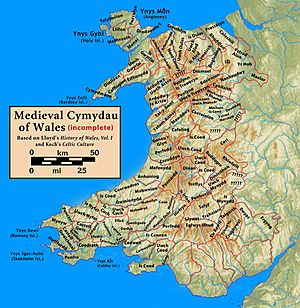Ystlyg facts for kids
Ystlyg was a special area in the Kingdom of Powys during the Middle Ages. It was like a large district called a cantref. Ystlyg was located in the eastern part of Powys, right on the border with England.
Contents
What Was Ystlyg?
Ystlyg was a medieval Welsh cantref. Think of a cantref as a big county or region. It was part of the Kingdom of Powys, which was an important Welsh kingdom a long time ago. The name Ystlyg might mean "curve" or "open country."
This area was very important because it was right on the edge of Wales, next to England. This made it a key place for trade and sometimes for battles between the Welsh and the English.
Ystlyg's Smaller Areas: Commotes
A cantref like Ystlyg was divided into smaller parts called commotes (or cymydau in Welsh). Ystlyg had four main commotes:
- Deuddwr: This was in the northern part of Ystlyg.
- Ystrad Marchell: This commote was in the middle of Ystlyg.
- Llannerch Hudol: Located in the southern part of the cantref. It had a few different spellings over time, like Llannerchwdwl or Llanerchydol.
- Y Gorddwr: This commote was unique because it was located to the east of the River Severn and Offa's Dyke. This meant it was actually on the English side of the border.
How Ystlyg's Lands Were Divided
For a while, three of Ystlyg's commotes – Ystrad Marchell, Llannerch Hudol, and Deuddwr – were known together as the Teirswydd. This Welsh word means "three commotes."
In 1263, these three areas were given back to a Welsh leader named Gruffydd ap Gwenwynwyn. This happened after he promised his loyalty and support to Llywelyn ap Gruffudd, who was a very powerful Welsh prince. This agreement took place at a place called Ystumanner.
However, the commote of Y Gorddwr was different. It stayed under the control of an English family, the Corbet family. This meant Y Gorddwr was under the rule of the English king, not the Welsh princes.
Ystlyg's Later History
After the medieval period, the area that was once the cantref of Ystlyg (but without Y Gorddwr) became known as the hundred of Deuddwr. A "hundred" was another way of dividing land for administrative purposes, similar to how counties or districts work today.


